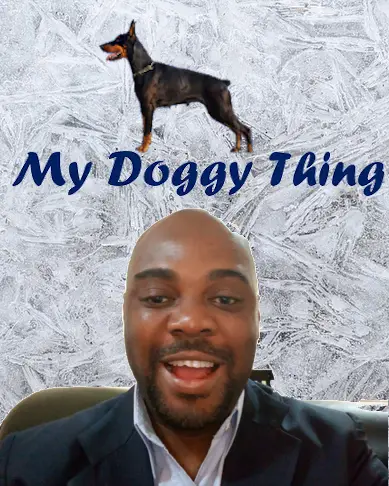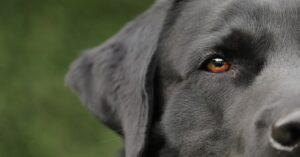WHY IS MY DOG JUST STANDING THERE?

The average dog is pretty much an active creature, taking out its time to investigate any new thing that comes its way with utmost concentration, almost like a private investigator. Be it a tree, bush, another pet, or even a human being both young and old in the vicinity, your dog would want to find out and understand the make-up and routine of these things. So if you find your “dog just stands in one spot” for a long time, you would definitely ask yourself “Why is my dog just standing there?”
Truth be told, there are so many reasons for your dog doing this, and is not something you should be very agitated about. So before jumping around in fear, saying to yourself “my old dog just stands and stares at me” there must be something very wrong. Your best course of action should be to consult with a vet doctor.
Still, we are going to show you the different reasons why your dog may just be standing there.
PAIN.
Dogs are naturally stoic in nature, they would go to great lengths to hide the pain they feel. Dogs behave differently depending on how severe the injury is and also the part of the body affected by the injury. For example, a dog with a paw injury would react differently from the way a dog with tooth pain will.
Some signs that a dog is undergoing pain are, shaking and trembling, hiding away in the corner, constantly looking down, refusing physical touch, hunched posture, whining and yelping, sleeping more than usual, having challenges getting up, or laying down, limping, lack of appetite, etc.
It is worth noting that dogs experiencing pain in the spinal region have a big problem controlling urinary and bowel functions and this can lead to uncontrollable urination and defecation.
So if you have been saying to yourself “my dog goes outside and just stands there” then it’s likely that your dog might be experiencing pain.
This begs the question, what can cause pain to a dog? There are so many things and situations that can lead to a dog experiencing pain. The expectation is that it will come from some injury or a chronic problem. Some of the potential causes of pain in a dog are: Back problems, Abdominal problems, Tissue, bone or joint injuries, Cancer, infection, Ingesting foreign objects, dental diseases, a recent surgery, etc.
If you suspect that your dog just standing there is because of an injury, you should consider taking a video or picture of your dog in his current state and contacting your vet doctor immediately.
Your vet will likely treat the pain depending on the cause. Medication, anti-inflammatory products, rest, diet, surgery, and sometimes therapy are some of the likely treatments your dog will be placed under.
ATTENTION.
“My dog just stands and stares at me“. Yes, your dog can just stand there and stare at you when they need attention. Our dogs are smart and intelligent creatures. If your dog gets some form of attention from you anytime they stand still, they would probably want to do the same thing over and over again. Each time they get attention from you, the behavior becomes more reinforced in them.
Boredom, insufficient exercise, lack of mental stimulation, excess energy, etc. all these can lead your dog to want attention from you. But apart from the above, there are other reasons why your dog would want attention from you.
i. Instruction or Direction: Your dog can just be standing there and staring at you because he or she needs to get instruction or direction from you. This is usually the case if you are going on a walk with your dog or are playing with your dog.
When on a walk your dog may stare at you in anticipation when reaching some crossroads and not being sure which direction you will be taking. The same thing when playing, your dog may stand and stare at you in anticipation of your next course of action to continue the play.
Doing this might be your dog’s way of asking you what next should we do.
ii. Asking you for food: If you are having a sumptuous meal and your dog is staring at you, then your dog is very much interested in the meal you are having. It’s worth noting that feeding your dog should be kept to a schedule, more so, there are things which we as humans can eat but our dogs cannot eat, and finally feeding your dog randomly can lead to bad habits and unrealistic expectations on the dog’s side.
iii. Confusion: Your dog just standing there and staring at you can come from being confused. This is common when you are engaging in some dog training or obedience program. When a command is issued repeatedly and your dog is not getting it. He or she might just stand there and stare at you.
iv. Needs something from you: Our dogs know that a good way of not just getting our attention but also getting things from us is to stare at us for a long time. Whether it is to get treats, cuddle with us or spend time with us, standing at a spot and staring at us for a long time would probably get us trying to figure out what our dogs might want.
v. To read your body language: Dogs are always understudying us. They would watch or stare at us for some time trying to make sense of our daily activities. They do this because they can’t communicate using words with us, so they would try to make sense of us and how we interact with each other based on the nonverbal cues we display.
vi. Aggressive Behaviour: Your dog may not do this to you. But it is possible to meet another dog for the first time and they stand and stare at you aggressively. This may be due to the training they get or they are just being overprotective of their environment.
Such a dog would maintain a stiff, hostile stance, stare at you with intensity, and more than often growl at you. The best thing you can do in this situation is to avoid the dog in totality and that includes making eye contact with them.
SEIZURES
When we hear of seizures we imagine violent movements, frothing, and convulsions, but there are other ways in which a dog can express seizures without violently moving its body. A dog can express his or her seizure by freezing or your “dog just standing not moving”. This is called a partial, focal, or petit-mal seizure.
A petit-mal seizure usually occurs due to disruptions in the electrical signals coming in or going out from the brain cells. This disruption leads to irregularities in the dog’s brain function which leads to loss of functionality at the moment. It can show itself in loss of muscle tone, unconsciousness, blank staring, etc. This can be compared to a piece of electrical equipment abruptly shut down and restarted. The period of the shutdown is synonymous with a lack of activity or awareness during that period.
Seizures in dogs generally are painless, but there is a lot of confusion because the dog would not be able to control his or her body in the instance.
So, how can you handle seizures when they occur in our dogs?
The first thing to do when your dog is experiencing seizures is to clear objects in their immediate surrounding which might end up being harmful to them.
The next thing to do is to consult your vet doctor for treatment. This is important so as to prevent scenarios where seizures can occur longer than normal which can lead to other health issues. Your vet doctor would likely prescribe medication based on the frequency, severity, and duration of the seizure. Keep in mind that the dosage suggested by the vet doctor must be followed to the letter.
Most seizure medication is to be taken for a lifetime by your dog.
Other approaches to treating seizures include homeopathic remedies, incorporating supplements, and dietary changes. Be sure to discuss these options with your vet doctor before implementing them.
FOOD POISONING.
It is usually surprising how many dog parents are not well informed about food poisoning when it comes to their dogs. Due to this Food poisoning is actually very common in dogs. Effects of food poisoning in dogs range from excess salivation, vomiting, diarrhea, abdominal pain, inappetence, and the one effects which causes a dog to just stand there like cramping, dizziness, nausea, and neurological disturbances.
Food poisoning can come from artificial chemicals in food, from food not properly preserved, or the food just not being good for the dog. Most dairy products have the probability of developing bacteria that can lead to food poisoning, sausages and gravies also fall under this category. Raw fish, undercooked meat, and eggs, all have the probability of carrying Salmonella bacteria which can be harmful to dogs.
You can learn more about things that can lead to food poisoning in your dog here:
23 worst things to feed a dog
What can you do if your dog is just standing there due to food poisoning?
The best thing to do is to contact a vet doctor immediately if you suspect food poisoning. Follow the instruction given to you to the letter as you may never know how critical the situation can be.
The next best thing you can do is to make sure your dog’s surrounding is free of possible food that can be poisonous to them. Dispose of food items properly especially leftovers from meals you have had. A secure dog-proof container can help you in this situation. Preserve your dog food at the temperature suggested by the manufacturers, especially wet dog food. If you are using your fridge to preserve dog food, kindly make sure the fridge is cleaned properly.
Finally, don’t leave your dog unsupervised for a long period of time. You can learn more about the natural food to feed you feed your dog here: Top 27 Natural Food To Feed Your Dog

PAST TRAUMATIC EXPERIENCES.
Just as past bad experiences can affect us as human beings at the moment, a dog finding himself or herself in a situation that brings up the memory of past traumatic experiences can just stand there and stare into space. In a sense, the dog may be in shock and lose temporary control of all functions.
Has your dog had the bad experience of being hit by a car, stepped on as a puppy, or some accident of some sort. Things that occurred just at the moment of these accidents can trigger them into a sense of helplessness making them freeze all of a sudden. Is it flashing lights, blaring horns, large baritone voices, etc? These sounds can occur in the moment and your dog would not have any appropriate response to them than to just stand there and freeze.
So, what can you do to prevent your dog from just standing there due to past traumatic experiences?
The first thing you should do is to liaise with your vet doctor to confirm that the situation is not a medical one. Once the situation is confirmed to be behavioral and not physical, you may contact an animal behaviorist to advise you properly on the next line of action.
This would likely be using various tricks to recondition your dog whereby the triggers which would cause your dog to freeze e.g loud noises, flashing lights, etc. would be now linked to positive experiences. Of course, he or she would have to understudy your dog for some time to come up with a suitable action plan.
HEARING AND SMELLING SENSITIVITY.
If you are asking yourself “why does my dog stare into space?”. It may all boil down to their hearing and smelling sensitivity. You see, dogs have over centuries and decades developed almost supernatural hearing abilities allowing them to tune in frequencies that are out of range to the human ear. Simply put, our dogs can hear things that we can only dream of hearing.
The same thing applies to their senses of smell. It is generally agreed that dogs can detect smells a hundred thousand times more than the average human can detect a smell. In fact, it is also scientifically on record that a dog can tell more about a person’s general preference, activities of the day, where they have been to, etc. from their smell than from their sense of sight.
When you combine these two, then there is a high probability that your dog is just standing there and staring into space because he or she has detected an interesting smell or sound and is trying to make meaning out of it. To bring it down a notch, your dog may be able to perceive a stranger entering your neighbor’s apartment, smoke for a far distance, or even the chirping of a new type of insect in the house.
Your dog just standing there in this situation is not really something to worry about. Although it might be wise to do your own investigation depending on where your dog focuses when he or she stares into that space. Some have been saved from dangerous situations like a snake hiding in the apartment or a bug infestation in a part of the building.
Yes, these are extreme situations but you will never know.
DEGENERATIVE DISEASES.
This disease can be defined as the progressive deterioration of a dog’s bones, tissues, and organs making them less and less functional. If you notice your dog acting a bit disoriented, stumbling, wobbling, or just standing there, then your dog might not just be tired but experiencing some form of a degenerative disease.
This is more suspect when you notice that the conditions exhibited are not getting better. Degenerative diseases unchecked can lead to a dog being permanently disabled and in some extreme cases even death.
If you suspect that your dog has a degenerative disease you should take him or her immediately to a vet hospital. Depending on the severity and how long the problem has been going on, your dog might be placed on medication, undergo some form of surgery, or be advised on lifestyle changes to make.
In addition to all these, scientifically formulated supplements are usually prescribed by the vet doctor to maintain a daily recommended dosage of vitamins, minerals, antioxidants, amino acids, and more. This together with a good dog will give your dog the proper nutrition it needs and improve its organ functions.
COGNITIVE DYSFUNCTION SYNDROME.
A sentence like “my dog is staring at nothing and shaking” can be an indication of your dog suffering from cognitive dysfunction syndrome.
This dysfunction occurs more in older dogs and can be compared to dementia or Alzheimer’s Disease in human beings. In a way, you can compare it to degenerative diseases, but the main difference is that the above is caused by a disease while the latter is a natural progressive failure in cognitive functions. It can not really be stopped but can be managed properly.
Symptoms of cognitive dysfunction syndrome include disorientation, changes in their sleep patterns, Inability to respond well to commands, Inability to recognize things, difficulty learning new things, getting lost, etc. You see, your dog would spend a lot of time trying to recollect or remember things making them just stand in a spot for a long period.
The bad news as we have already stated is that this condition is irreversible. The good news is that the condition can be managed and the progression of the syndrome can be heavily slowed down.
How do you treat a dog just standing there from cognitive dysfunction syndrome?
The common treatment would involve a need to improve their nutrition with vitamin E and C, carnitine, omega-3, antioxidants, carotenoids, and fatty acid-rich diet to keep their brain as healthy as possible, there is also the need for regular mental stimulation at this stage. You see, a dog with cognitive dysfunction syndrome would be heavily in need of lifelong support and therapy.
Your vet doctor would likely prescribe some medication for your dog in addition to the above. You will need a way to constantly monitor your dog and stimulate them mentally through regularly exercising, playing, and training.
Just doing this and following your vet’s instruction to the letter would help to slow down the progression of this syndrome on your dog.
IN CONCLUSION
We have addressed the question “why is my dog just standing there?” in detail and you are armed with all the information you need to be proactive in this instance, but like we always say, our dogs want our love and companionship more. The knowledge of what to do is just an added advantage, improving your dog’s trust in your and allowing you to create a situation where you and your dog would be happy with each other.
DOG CARE
DOG PRODUCTS
DOG BREEDS

Hi, I am Charles Nwankwo Editor-in-Chief, Mydoggything.com. Gleaning from Professional Dog Trainers, behaviorist, Registered Veterinarians, and Breeders. We are passionate about making dog care easy for you. My job is to make sure that you get the best-updated dog care information to understand and take care of your dog or dogs.









